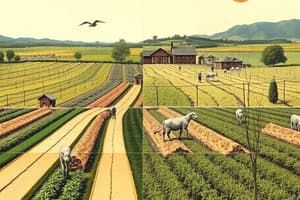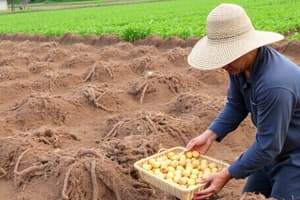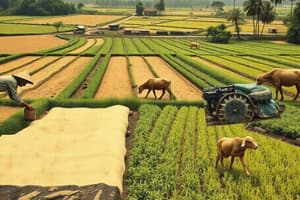Podcast
Questions and Answers
What is the most important factor for sustainability in a farming system?
What is the most important factor for sustainability in a farming system?
Soil health
What are the three major groups of factors that determine the type of farming system used in a region?
What are the three major groups of factors that determine the type of farming system used in a region?
Physical and biological elements, endogenous human elements, and exogenous human elements.
Which of the following cropping systems involves growing two or more crops simultaneously on the same field with no distinct row arrangement?
Which of the following cropping systems involves growing two or more crops simultaneously on the same field with no distinct row arrangement?
- Strip intercropping
- Mixed intercropping (correct)
- Relay intercropping
- Row intercropping
What is the main objective of a cropping system?
What is the main objective of a cropping system?
What are the three working hypotheses of farming systems?
What are the three working hypotheses of farming systems?
What are the main components of a farming system (according to the diagram in Chapter 2)?
What are the main components of a farming system (according to the diagram in Chapter 2)?
What is the core objective of sustainable farming systems?
What is the core objective of sustainable farming systems?
What advantages do sustainable farming systems offer?
What advantages do sustainable farming systems offer?
The term 'mixed farming' is identical in meaning to 'farming system'.
The term 'mixed farming' is identical in meaning to 'farming system'.
Which of the following is NOT a factor that affects the types of farming systems in India?
Which of the following is NOT a factor that affects the types of farming systems in India?
Define the term 'cropping intensity'.
Define the term 'cropping intensity'.
Which of the following is a key advantage of intercropping?
Which of the following is a key advantage of intercropping?
Explain the concept of 'allelopathy' in intercropping.
Explain the concept of 'allelopathy' in intercropping.
What are the three broad categories of overall effects of competition in intercropping?
What are the three broad categories of overall effects of competition in intercropping?
What are the objectives of an integrated farming system?
What are the objectives of an integrated farming system?
Which of the following is NOT a benefit of integrated farming systems?
Which of the following is NOT a benefit of integrated farming systems?
Name four examples of components commonly included in integrated farming systems.
Name four examples of components commonly included in integrated farming systems.
What are the steps involved in preparing a model integrated farming system for a specific situation?
What are the steps involved in preparing a model integrated farming system for a specific situation?
What are the key factors influencing the selection and size of components in integrated farming systems?
What are the key factors influencing the selection and size of components in integrated farming systems?
What are three advantages of intercropping?
What are three advantages of intercropping?
Describe the concept of 'crop rotation' and why it is crucial for soil health.
Describe the concept of 'crop rotation' and why it is crucial for soil health.
The 'land equivalent ratio' (LER) is a widely used index to assess the yield advantage of intercropping systems.
The 'land equivalent ratio' (LER) is a widely used index to assess the yield advantage of intercropping systems.
What are the main challenges that India faces regarding food security in the face of a growing population?
What are the main challenges that India faces regarding food security in the face of a growing population?
What are the key strategies for increasing agricultural productivity in India?
What are the key strategies for increasing agricultural productivity in India?
What is the role of 'cropping pattern' in a farming system?
What is the role of 'cropping pattern' in a farming system?
What is the main purpose of 'agroforestry'?
What is the main purpose of 'agroforestry'?
What are the potential benefits of integrating trees into farming systems?
What are the potential benefits of integrating trees into farming systems?
Which of the following is NOT a commonly used index to assess the efficiency of cropping systems?
Which of the following is NOT a commonly used index to assess the efficiency of cropping systems?
The relative yield index (RYI) is calculated by dividing the mean yield of the crop in the zone by the mean Indian yield.
The relative yield index (RYI) is calculated by dividing the mean yield of the crop in the zone by the mean Indian yield.
What are the primary challenges in managing agricultural labour resources?
What are the primary challenges in managing agricultural labour resources?
What are some effective strategies for improving labour productivity in agriculture?
What are some effective strategies for improving labour productivity in agriculture?
What are the key factors to consider for selecting the appropriate site for a biogas plant?
What are the key factors to consider for selecting the appropriate site for a biogas plant?
Describe the concept of 'agroforestry' and its potential benefits for sustainable land management.
Describe the concept of 'agroforestry' and its potential benefits for sustainable land management.
Which of the following is NOT a commonly practiced integrated farming system in India?
Which of the following is NOT a commonly practiced integrated farming system in India?
Explain the importance of 'resource recycling' in integrated farming systems and provide two examples.
Explain the importance of 'resource recycling' in integrated farming systems and provide two examples.
What are the key challenges faced by farmers in India related to water availability and efficient water management?
What are the key challenges faced by farmers in India related to water availability and efficient water management?
What are some strategies to manage water scarcity in irrigated areas?
What are some strategies to manage water scarcity in irrigated areas?
The growth rate of food grain production in India has consistently outpaced the rate of population growth in recent years.
The growth rate of food grain production in India has consistently outpaced the rate of population growth in recent years.
Integrated farming systems are particularly crucial for which type of farmers?
Integrated farming systems are particularly crucial for which type of farmers?
What are some key challenges faced by farmers in India related to labor management?
What are some key challenges faced by farmers in India related to labor management?
What is the main difference between maintaining livestock in a sole enterprise and integrating livestock into an integrated farming system?
What is the main difference between maintaining livestock in a sole enterprise and integrating livestock into an integrated farming system?
Flashcards
What is a system?
What is a system?
A group of interacting components working together for a common purpose. It reacts as a whole to external stimuli and has a defined boundary that includes all significant feedback.
What is a farming system?
What is a farming system?
A strategy to achieve profitable and sustained agricultural production that meets the needs of the farming community while efficiently utilizing resources and preserving the environment.
Farming systems approach
Farming systems approach
The approach of viewing a farm holistically, integrating various enterprises like crops, livestock, and aquaculture, to maximize resource utilization and profitability.
Concept of farming systems
Concept of farming systems
Signup and view all the flashcards
Principles of farming systems
Principles of farming systems
Signup and view all the flashcards
Characteristics of farming systems
Characteristics of farming systems
Signup and view all the flashcards
Objectives of farming systems - Productivity
Objectives of farming systems - Productivity
Signup and view all the flashcards
Objectives of farming systems - Profitability
Objectives of farming systems - Profitability
Signup and view all the flashcards
Objectives of farming systems - Potentiality
Objectives of farming systems - Potentiality
Signup and view all the flashcards
Objectives of farming systems - Balanced food
Objectives of farming systems - Balanced food
Signup and view all the flashcards
Objectives of farming systems - Environmental safety
Objectives of farming systems - Environmental safety
Signup and view all the flashcards
Objectives of farming systems - Income/cash flow round the year
Objectives of farming systems - Income/cash flow round the year
Signup and view all the flashcards
Objectives of farming systems - Saving energy
Objectives of farming systems - Saving energy
Signup and view all the flashcards
Objectives of farming systems - Meeting fodder crises
Objectives of farming systems - Meeting fodder crises
Signup and view all the flashcards
Objectives of farming systems - Solving timber and fuel crises
Objectives of farming systems - Solving timber and fuel crises
Signup and view all the flashcards
Objectives of farming systems - Employment generation
Objectives of farming systems - Employment generation
Signup and view all the flashcards
Objectives of farming systems - Scope for establishment of agro-industries
Objectives of farming systems - Scope for establishment of agro-industries
Signup and view all the flashcards
Objectives of farming systems - Enhancement in input use efficiency
Objectives of farming systems - Enhancement in input use efficiency
Signup and view all the flashcards
Farming system definition (Fresco and Westphal, 1988)
Farming system definition (Fresco and Westphal, 1988)
Signup and view all the flashcards
Determinants of farming systems - Factor A
Determinants of farming systems - Factor A
Signup and view all the flashcards
Determinants of farming systems - Factor B
Determinants of farming systems - Factor B
Signup and view all the flashcards
Determinants of farming systems - Factor C
Determinants of farming systems - Factor C
Signup and view all the flashcards
What is a cropping system?
What is a cropping system?
Signup and view all the flashcards
Definition of cropping system
Definition of cropping system
Signup and view all the flashcards
Objective of cropping systems
Objective of cropping systems
Signup and view all the flashcards
Mono-cropping
Mono-cropping
Signup and view all the flashcards
Multiple cropping
Multiple cropping
Signup and view all the flashcards
Intercropping
Intercropping
Signup and view all the flashcards
Sequential cropping
Sequential cropping
Signup and view all the flashcards
Crop rotation
Crop rotation
Signup and view all the flashcards
Study Notes
AGR 102 (2+1): Farming Based Livelihood Systems
- Course for first-year B.Sc. (Hons) & ABM students
- e-Notes compiled by Dr. C. P. Chandrashekara & Dr. B.N.Aravind Kumar, Professors of Agronomy
- College of Agriculture, Dharwad, UAS, India
Topic Covered in Specific Weeks
- Week 1: Status of agriculture in India and different states, income of farmers and rural/urban populations.
- Week 2: Definition, concept, and patterns of livelihood in urban and rural areas, different indicators for studying livelihood systems.
- Week 3: Agricultural livelihood systems (ALS): meanings, approach, approaches, and framework.
- Week 4-5: Definition of farming systems and farming-based livelihood systems, scope, components, principles, role and importance.
- Week 6: Factors affecting farming systems, characteristics of farming systems, why sustainable farming systems, advantages of sustainable farming systems, classification - historical background, objectives, and characteristics of integrated farming system (IFS).
- Week 7: Components of farming systems/farming-based livelihood systems, components of IFS/ enterprises and their selection, management methods and steps in building a model IFS. Recycling in IFS.
- Week 8: Types of farming systems, and factors affecting types of farming, components, classification of farming system.
- Week 9: Different kinds of farming systems, components of IFS, enterprise selection & management, considerations, and examples of various farm enterprise combinations and factors influencing their choice.
- Week 10: Concepts related to cropping systems, terms, and definitions, different cropping systems (e.g., mono, multiple, intercropping), principles of cropping system, types of cropping systems, forms of multiple cropping.
- Week 11: Crop rotation: definition, advantages, and disadvantages; principles of crop rotation; plant interactions in intercropping; criteria for assessing yield advantages in intercropping.
- Week 12: Efficient cropping systems and their evaluation; interrelationships/interactions in intercropping systems (e.g., competitive, non-competitive, complementary).
- Week 13: Farming system components and their maintenance, including livestock, agroforestry, aquaculture, different enterprises and their interactions.
- Week 14: Factors affecting integration of enterprises for livelihood; feasibility and models of different farming systems related to climates; examples.
- Week 15: Risk and success factors in farming-based livelihood systems, case studies.
- Week 16: Resource management under constraint situations and optimization techniques, efficiency of labour management; schemes and programmes of the central and state government, Public and Private organizations involved in promotion of farming-based livelihood.
- Week 17: Role of farming systems in the 21st century in view of the changing lifestyle and roles of circular and green economies, digitalization.
- Week 18-21: Practical sessions with field visits involving dairy, sheep/goat, fish, poultry rearing, and production practices, study of start-ups in the agricultural sectors, Suggested readings, and relevant references.
Important Concepts
- Farming Systems: A set of interconnected farm enterprises (crops, livestock, etc.) that function as an integrated unit.
- Integrated Farming System (IFS): Combining different enterprises to optimize resource utilization, maximize income, and ensure sustainability.
- Sustainable Farming System: Farms that can adapt to changing conditions, preserve natural resources, and maintain long-term productivity.
Critical Factors affecting Farming Systems (Determinants)
- Factor A (Physical and Biological): Land, soil quality, topography, climate, water availability.
- Factor B (Endogenous Human): Family size, management skills, education, labour availability, capital, access to credit.
- Factor C (Exogenous Human): Policies, infrastructure, and socio-economic conditions.
Important Cropping Systems
- Sole Cropping (Monoculture): Growing one crop on the same land.
- Multiple Cropping: Growing two or more crops in the same field.
- Intercropping: Growing two or more crops together in the same field.
- Sequential cropping: Growing two or more crops in sequence.
- Crop Rotation: Growing different crops on the same land in a succession.
- Multitier Cropping: Growing several crops at different heights or layers on the same land.
Important Concepts (Other)
- Land Equivalent Ratio (LER): A measure of the effectiveness of intercropping, in terms of land use.
- Relative Yield Total (RYT): Measures the yield advantage of an intercrop compared to the total yield of each component crop.
- Relative Crowding Coefficient (RCC): Quantifies the relative impact of a species on production.
- Crop Intensity Index (CII): Indicates the number of times land is cropped in a year.
- Crop Equivalent Yield (CEY): Useful in comparing the economic output of many kinds of crops.
- Agroforestry: A practice involving combining trees with crop or livestock production.
Studying That Suits You
Use AI to generate personalized quizzes and flashcards to suit your learning preferences.
Related Documents
Description
This quiz covers the key concepts of Farming Based Livelihood Systems as outlined in the AGR 102 course for first-year B.Sc. (Hons) & ABM students. Topics include the status of agriculture in India, livelihood patterns, and sustainable farming systems. Test your understanding of these important agricultural principles and their applications.




